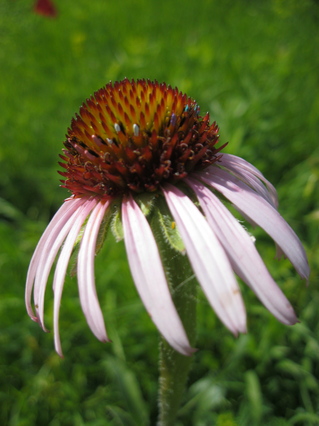The Echinacea Project posted a job description for a postdoctoral position and details about how to apply. Applications will be reviewed starting 19 March 2012 and will be accepted until positions are filled. Learn more.
|
||||
|
The Echinacea Project posted job descriptions for field research internships for summer 2012 along with details about how to apply. Applications will be reviewed starting 29 February 29, 2012 and will be accepted until positions are filled. The text of an ad to be distributed is copied here… Are you interested in gaining field research experience and learning about the ecology and evolution of plants and plant-animal interactions in fragmented prairie? We are looking for 3-5 summer field researchers for an NSF-funded project on habitat fragmentation of the tallgrass prairie. We are investigating how small plant population size influences inbreeding, demography, pollination, and herbivory in the purple coneflower, Echinacea angustifolia. This is a great summer internship, REU, or co-op for those interested in field biology or conservation research. No experience is necessary, but you must be enthusiastic and hard-working. You will survey natural plant populations, measure plant traits in experimental plots, hand-pollinate plants, observe & collect insects, and assist in all aspects of research. Housing is provided and there is a stipend. Undergraduate students have the opportunity to do an independent project as an REU participant. Look at them go! For the first few seconds of the video, anway, 2:00 pm winds WSW 1 ew left/row [?] [entered from notes in 2012; see plantOenotheraNov2011.pdf] My name is Jill Meyer and I am a student intern working on the Echinacea Project. We were sitting and cleaning heads in the lab when I had found an exoskeleton of a molted grasshopper. It was a new and exciting discovery for me, as I did not previously know that grasshoppers molt. I have always been semi-fascinated with bugs, so I placed the grasshopper’s exoskeleton in the drawer to save. Since then, my collection has grown and I have added an Assassin Bug, a spider egg sac, a lacewing fly and a pentatomid. These can be found below. Unfortunately, the insects have fallen apart in the envelope I have kept them in and their limbs are captured laying next to their bodies. I have also written a lab procedure on how to take these images using a microscope, which I have also included below. My first goal of the crossing attempt was to determine the rate of floret emergence. The second major challenge was to isolate individual florets so that I could control pollination. I first found suitable plants without any emerged florets, then covered the terminal spike with a mesh bag that was secured to the stem using a twist-tie. Stems were supported by tying them loosely to a pin-flag. Then, I marked the pin-flag with labeled fluorescent orange flagging. I followed this procedure for each of ten haphazardly selected plants at the Nice Island remnant. To examine the rate of floret emergence, I visited plants every two to three days. The first burst of flowering occurred during hot days in mid-July. Following the first 2-3 rows of opened florets, I secured a length of embroidery floss around the spike to demarcate emerged florets from the still closed floral buds. I then immediately replaced the mesh bags following belt application. I determined that florets opened at the rate of one to two rows per day, progressing from the bottom to the top of the spike. This species is primarily outcrossing. Pollination was attempted using haphazardly collected pollen at the same site with fresh toothpicks. Pollen was stored into new microfuge tubes in the freezer. I later applied this random donor pollen to floret stigmas at ten plants. This crossing protocol had some challenges. First, the close organization of florets on the inflorescence made individual crosses impractical. Second, a relatively delicate stem did not allow for snug closure of the mesh bag and twist-tie, resulting in insects inside the mesh. Third, the size of the mesh (aperture size) was such that most stamens poked out through the mesh. It was concluded that crosses of this species will require a different approach. For pictures, visit the Dalea page at The Echinacea Project 12 August 2011 The Echinacea Project established a new website at echinaceaProject.org. We designed an experiment to assess how fire affects the growth of plants. This spring we will plant about 2500 seedlings in 2500 randomly assigned locations on a 1m x 1m grid. We aim to keep track of the identity of all individuals and plant them quickly and efficiently. Here are five datasheets that will help: pathsToPlant.pdf, plantingDataSheet.csv, plugRowsPerPath.pdf, trayInfoByPseg.pdf, trayInfoByRow.pdf 11 Jan 2011 Greg Diersen describes his adventures with Team Echinacea and presents a lesson plan in a new paper: Diersen, G. T. 2011. Team Echinacea & construction of a key using online images of fresh prairie plant pollen. The American Biology Teacher 73:35-38. PDF |
||||
|
© 2024 The Echinacea Project - All Rights Reserved - Log in Powered by WordPress & Atahualpa |
||||






